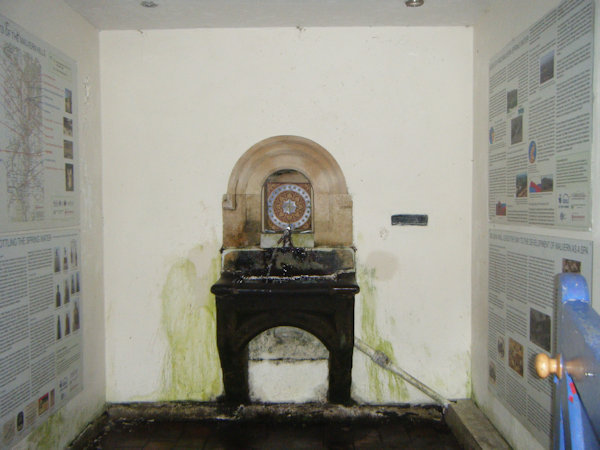 |
Dedication: none Location: Malvern Wells Coordinates: 52.0788N, -2.3365W Grid reference: SO770423 Heritage designation: Grade II listed building |
HOME - ENGLAND - WORCESTERSHIRE
 |
Dedication: none Location: Malvern Wells Coordinates: 52.0788N, -2.3365W Grid reference: SO770423 Heritage designation: Grade II listed building |
The Holy Well is one of several famous springs in the area, all of which became popular in the 18th and 19th centuries on behalf of the Malvern Water Cure. It is thought, in fact, that the earliest mention of the so-called "Malvern Water" was made in 1622 in Bannister's Breviary of the Eyes:
|
A little more I'll of their curing tell, |
This verse, however, likely refers to the "Eye Well", which is located slightly above the Holy Well. The earliest mentions of the Holy Well that I have been able to find date from the late 17th century, although it is clear that the spring had much fame before these references were made. One of these is a description of the Holy Well that was made in 1670 in a publication of the Royal Society called Philosophical Transactions:
|
But much greater is the reputation of the Holy-Wells, as they call them, on the ſide of Malvern Hills, which Hills divide Worceſter-ſhire from Hereford-ſhire. The higher Spring is peculiar for the Eyes; About a furlong lower is the Healing Spring [this is the Holy Well] this cureth many Maladies and Cancers, if applied before the ſtrength'of Nature be overthrown. I have read in the Monuments belonging to the Hoſpital at Ledburg, a Town on the way from Hereford to thoſe Springs, that a Biſhop, ſome Ages paſt, endowed that a Hoſpital with revenues, for the entertainment of diſtreſſed Paſſengers that traveyled to thoſe Springs for relief. 'Tis above 50 years ſince I heard a Panic ſtory ſpread all over the City and Country of Worceſter, that the Phyſicians had poyſoned thoſe Wells. I am perſwaded that the ground of this Fable was only thus: After more than ordinary Rain for one, two or three years together (as it falls out ſometimes in England) ſome common waters, by a part of the ſame, or ſome other channel, do drive to the ſame apperture, and drown the excellency of the healing Water. In this droughty year we find, that many excellent Springs have loſt more than half, and ſome more than four parts of five of the waters which they did uſually afford in the ſame ſeaſons of other moyſter years.... But Fooliſh people go ſweating up the Hill, and then drink the cold water; or apply it Cold to their heated Ulcers, and then what good can be expected? And (withal) theſe waters are kindeſt to the Poor and jejune people, who are accuſtomed to drinks almoſt as weak as water. |
Foolish or not, the Holy Well's fame only increased at the turn of the 18th century, after which the concept of cold bathing really gained traction with the general public. In 1738, Thomas Cox mentioned the spring's popularity in A New, Exact, and Comprehensive Survey of the Ancient and Preſent State of Great-Britain, and Dr. John Wall, a prominent Worcester physician of the 18th century who began a bottling plant at the Holy Well, published a treatise, named Experiments and Observations on the Malvern Water, on the well in 1756, which detailed the attributes of the spring. He performed several tests on the spring water, and, upon finding that it contains absolutely nothing at all, he decided that its efficacy lay in its unusual purity. He quickly published a second edition of his treatise, which included countless accounts of healings that supposedly had occurred at the Holy Well. Within this publication, he described the traditional way in which visitors to the well would use the water:
|
I always adviſe my Patients to drink freely of the Water for ſome Days or Weeks before they uſe them externally. The Empirical Method of Application, which has hitherto been ſucceſsfully practiſed, is to waſh Sores, Tumours, &c. under the Spout, ſeveral Times in a Day; covering the Parts afterwards with Cloths dipt in the ſame Water, and moiſten'd from Time to Time, as often as they grow dry. -- Thoſe who bathe alſo for cutaneous Foulneſſes uſually go into the Water with their Linnen on; and dreſs upon it wet. This Method, odd as it is, has never yet, that I have heard of, been attended with any ill Conſequences; though I have known it uſed by ſeveral very tender Perſons... |
This practice was widespread, and it was also described in a letter that was written (by Dr. John Wall) to the Gentleman's Magazine in 1758 that detailed the curing of an eight year old boy from Leicestershire of terrible ulcers:
|
...I thought his caſe incurable, and told his friends ſo; but as they had brought him ſo far, they were deſirous that he ſhould make trial of the water. After ſome little preparation, therefore, he enter'd upon its uſe. He drank it twice a day at the ſpring head, and it was his only drink at home; the diſeaſed parts were waſhed twice a day under the ſpout, and were afterwards wrapt up in linnen rags kept conſtantly wet with the water; and after he had uſed it in this manner for a fortnight or three weeks, he was every morning put into the bath. This was the whole method, for he took not a grain of any medicine after he began upon the water. |
In 1764, Alexander Sutherland summarised the ailments that the Holy Well was believed to be especially effective in the curing of, which he published in An Attempt to Ascertain and Extend the Virtues of Bath and Bristol Waters by Experiments and Cases:
|
From experience, confirmed by Caſes incontrovertible, we learn, That it has proved eminently ſerviceable in ſcrophulous caſes, old ulcers and fiſtulas, obſtructed glands, ſchirrous and cancerous caſes, diſorders of the eyes and eye-lids, diſorders of the urinary paſſages, cutaneous diſeaſes, coughs ſcorbutic and ſrophulous, loſs of appetite, and profuſe female diſcharges... |
The Holy Well was also thought, according to G. Nelson, writing in 1740 in The Wonders of Nature, to have had the power to remove "Sun-burning and Freckles". Dr Wall, however, when recording the stories of miraculous curings at the well, focused mainly on cases of leprosy and scrofula. Several of these cases, most of which were included in the second edition of his treatise (in which he added more stories of healings to the original booklet), can be seen below:
|
Such an Effect they had upon the late Edward Popham Eſq; of the Lodge near Tewkeſbury. - This Gentleman was quite crippled by the Gout, and had in a manner loſt the Uſe of all his Limbs. The marvellous Cures perform'd at the Holy Well, induced him, about ten Years ago, to make Trial of it. After He had drank the Water about a Month, a violent Diarrhaea came on, and laſted ſeveral Days, from which he found great Relief; recovering his Spirits, and in great Meaſure, the Uſe of his Limbs. As a Teſtimony of the Benefit he had receiv'd, He built a Bath under the Spout; the ancient one being in a very ruinous Condition. Margaret Webb was receiv'd on Tryal Auguſt the 31ſt 1755 as an In Patient of the Worceſter Infirmary, for a ſinuous Ulcer in the Groin, which penetrated into the Abdomen; beſide which She had another alſo on the outſide of the Thigh which the Probe could not fathom. She continued in the Houſe till September 25th; but the Air of the Place, where many ſick Perſons lie in one Ward, being too cloſe for her; and her Caſe being thought deſperate; She was made an Out Patient: at which Time, She was very much reduced, and grown hectical by the Diſcharge; which was exceſſively faetid; and ſo great in Quantity, as to run through all the Dreſſings quite down on the Floor, whenever She ſat up a quarter of an Hour. Soon after this She was carried to the Holy Well; and She had drank the Water, and applied it to the Sores but a ſhort Time, before the Diſcharge was conſiderably leſſen'd thereby; and the Faetor entirely removed. The Matter, which before was thin and ichorous, grew thick and well contidion'd; She loſt the hectic Symptoms; her Strength improved daily; and the Ulcer in the Groin was ſoon heal'd perfectly... Mr. John Ible, of the Pariſh of Stockton in this County, had been afflicted with a dry furfuraceous Leproſy more than ſeven Years. This firſt appear'd about the Knees and Elbows, but ſpread by Degrees over the whole Body. Every Night, he left in his Bed two or three Handful of dry Scales, as large as thoſe of a Carp. By drinking conſtantly of the Holy Well Water, and bathing in it three or four Times in a Day, He was cured in ſeven Weeks. He viſited Malvern again the next Spring; (A.D. 1754) but rather out of Precaution than Neceſſity: not having had any Return of his former Complaints. This Account I had from Mrs. Greene at whoſe Houſe he lodged. Elizabeth Price, of Driotwich, Aged 56 had had a Leproſy ſeven Years, which cover'd her Arms, Legs, and Thighs; and in all theſe Parts were many filthy Fiſſures. The Diſeaſe firſt arose from her drinking cold Cyder when She was heated by violent Exerciſe. She obtain'd a Cure this Year in five Weeks Time; by drinking and bathing in the Holy Well Water, and dreſſing upon her wet Linnen. Her Skin is now perfectly ſmooth. He ["Mr. Cam, an eminent Surgeon in Hereford"] inform'd Me, on his own Knowledge, that Capt. Cocks, a Gentleman who formerly kept a large Pack of Hounds in this Neighbourhood, never uſed any other Means to cure the Mange in his Dogs, but dipping and waſhing them in the Holy Well Water. The Rev. Mr. Boulter, Vicar of Kemſey, in this County, when a Boy at School in Malvern, receiv'd a violent hurt on the Shin Bone; which being neglected, formed a large and deep Ulcer. He tells me that it look'd quite black, and a Mortification was apprehended; but was ſoon perfectly cured by the Malvern Water, without any other application. I have ſeen the Leg; and from the Largeneſs of the Scar, and the Skin tucking down, apprehend that the Bone was bare. A young Woman, Daughter of a Tradeſman in Bewdley, had long had a Schrophulous Opththalmy in each Eye, which made her unable to bear the Light. She had been in this miſerable Condition eight or nine Months; and though She had applied to ſeveral Perſons of Skill, had not met with any permanent Relief. I advis'd Her at length to try Malvern Water. -- When She was brought to the Well, she could not open her Eyes, but was forced to be led by another Perſon; but ſhe had not uſed the Waters more than a Week, before ſhe was ſo much recover'd that ſhe could ſee a Flea leaping on her Bed. |
It also appears that the Holy Well was thought to be effective in the curing of kidney stones, although Dr Wall makes no mention of this in his treatise. Thomas Percival mentioned this in an essay that was published as part of volume 1 of a publication entitled Philosophical and Experimental in 1788:
|
Malvern Water, which issues from a ſpring, in Worcestershire, remarkable for its uncommon putiry, hath the property of diſſolving the little ſabulous ſtones, which are often voided in nephritic complaints. |
The Holy Well has been the subject of many experiments over the centuries, but possibly one of the strangest is one that was conducted by Ambrose Dawson, a physician notable enough to have his own (albeit short) Wikipedia page, in the late 18th century. He spoke about his experiment at the College of Physicians (of which Dawson was a member) on the 15th of August, 1769; his speech was recorded and published in volume 2 of Medical Transactions in 1786. Dawson must have been aware of the superstitioun that water from the Holy Well was able to "diſſolve" kidney stones, and was thus motivated to conduct an experiment on it. At the beginning of his speech, he warned that "the experiments I made, though pleaſing in the purſuit, may be dull in the relation". His account of the experiment is as follows:
|
A gravel ſtone weighing gr. iv. paſſed by a boy, was diſſolved in C 3ſs. - Gravel ſtones from the ſame boy, weighing gr.ii, were infuſed in Malvern water; but except a few adhering bubbles, which ſoon diſappeared, no impreſſion was made on them. I dropt ſp. of ſea ſalt 3ii on ſome of the ſtones taken out of the Malvern water, but not a bubble was ſeen. A freſh ſtone from the ſame boy was dropt into the acid ſpirit, and a very few bubbles appeared; but, after ſome days, no other alteration was diſcovered. |
Despite what his experiment proved, the popularity of the Malvern Waters continued to increase as a, so to speak, "universal cure". If Dr Wall is to be believed, then there is nothing that the water of the Holy Well cannot heal. This view was expressed rather humourously in the "Poetical Essays" section of the Gentleman's Magazine in May 1755 in a short poem that was addressed to Dr Wall, on the "publiſhing of his Experiments and Obſervations of on the Malvern Waters"; the last few verses refer directly to the Holy Well:
|
Here Lepers, of a frightful hue, To health and vigour, by degrees,
Here, from the brink of darkneſs drawn,
O Malvern! never envy thou
Henceforth ſhall rapt'rous poets ſing
We too of inſpiration tell, |
Although the "Malvern Water" may not have been as popular in the 1700s as it became in the 19th century, a small bottling industry had developed around the Holy Well. It was not just Dr Wall who bottled water at the spring; the drink was also sold by a Mr Owen, whose bottling company was afforded a brief advert at the end of Richard Russel's Dissertation on the Use of Sea Water in the Diseases of the Glands, which was published in 1790:
|
As having theſe Waters, and indeed all others, GENUINE, is of the greateſt Conſequence to thoſe who drink them, we can ſafely recommend the Malvern Water that is ſold by Mr. Owen (Succeſſor to the late Mr. Eyres), at his Mineral-Water Warehouſe in Fleet-ſtreet, being filled and ſealed under the Inſpection of Mr. Davis, Apothecary and Chymiſt in Worceſter; who, together with Dr. Wall of the ſame City, hath made many ingenious Experiments on theſe Waters. |
From all accounts, throughout the entirety of the 18th century, a bath was located at the Holy Well; the story that Edward Popham rebuilt this bath after the older one had fallen into disrepair is probably very true. There was some sort of building too, either over or near to the well, although it probably did not look like the one that stands there today. One of the few descriptions of this building that I could find was made by the Reverend J. Barret in A Description of Malvern (1796), who stated that the "ſource of the Holy-Well is ſecured by a decent building, containing a bath and ſeveral apartments ſuited to the various purpoſes that uſing the water require". A very similar description of the building (almost word for word, in fact) was written by John Feltham in 1803, only a few years after Barret, who illustrated the popularity of Malvern as a spa town even before the Victorian era began:
|
In cancerous complaints, old ulcers, glandular obstructions, and other complaints for which Malvern water has been prescribed, drinking, lotion, and bathing, according to circumstances, must be used. Early rising, excercise on foot or horseback, with temperance, must be combined with the water; and if the former are regularly persued and observed, the effects of the latter will be a consequence rather than a cause. The source of the Holy-well is secured by a convenient erection, containing a bath and other accommodations; and at a small distance is a large and commodious lodging-house, capable of receiving a considerable number of people, who dine at a public table, and live very sociably together. Here is also a billiard-room to amuse them in bad weather; but such is the romantic situation of the place, and the indescribable beauty of the landscapes, that strangers for some time will feel little disposition to ennui, if they enjoy their eye-sight. Company, however, seldom stay long in this place; but there is a constant succession from Cheltenham, and many other parts of the kingdom, during the summer season. |
In the 19th century, the concept of the "Malvern Water Cure" became more popular seemingly than ever before. Accounts of "patients" from the time, such as that of Edwin Paxton Hood, who published a series of letters that he had written during his time as a "patient" in Records of a Water Patient in Malvern, show that several different competing "hydropathic establishments" existed in Malvern simultaneously, each one under the supervision of a different doctor who specialised in the Water Cure. Among these countless "establishments" were Rayner's Hydropathic, Leicester House Hydropathic (which cost 42 shillings a week), and Townsend House. Most "patients" were upper class men and women who stayed in Malvern for long periods of time, enduring a range of mostly unpleasant "treatments".
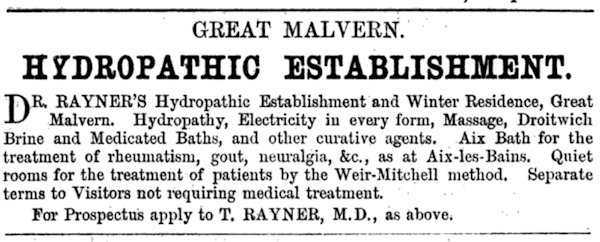 |
 |
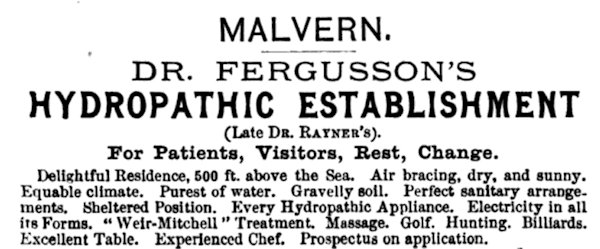 |
A patient's typical day would begin at around 6am, when they would be wrapped in a wet sheet (wet with water from one of the Malvern springs, and often from the Holy Well) for an hour or so; this went by the name of "packing". Joseph Leech, in Three Weeks in Wet Sheets; Being the Diary and Doings of a Moist Visitor to Malvern, which was published in 1851, described his "first packing":
|
So I got up and stood shiveringly observant of his proceedings as he stripped my bed to the mattress. On this mattress, he spread four or five blankets in succession, and then a wet sheet, slightly wrung out of the bath. On this sheet, which extended to the bolster, I lay myself down, my head on the pillow, and ugh! what a chill it sent through my frame as the fellow wrapped it round my warm body in close contact with the skin - he folded it close, tucked it in tightly, so that it enclosed me as a wet winding-sheet; then each layer of blankets was drawn over and pressed round me in the same manner, and finally my counterpane; until I formed a bundle of blankets with a wet sheet under all. |
After around an hour, the patient would be "unwrapped", and would be subject to a shower, of sorts, which was known as the "douche". The specifications of this treatment varied slightly from establishment to establishment, but the essential concept was described by Leech:
|
To each Douche Bath there are two dressing-rooms, so that no time may be lost, or one party have to wait until the other is quite habited. From the dressing-room you descend some eight or ten feet, by a flight of steps, into a place or pit floored with open wood-work, in order that the water as it falls may run off from the feet. From the roof two large long pipes, one nearly two and the other about three inches in diameter, point menacingly down on you. According to your case or constitution, you get your bath through one or the other, but the larger one, which is that more generally used, is capable of launching down on the body, in a straight, unbroken column of water, one hogshead per minute, and that with such force, the fall being more than twenty feet, that when it struck me straight on the shoulder it knocked me clean over like a ninepin. |
Among various other "treatments", it was deemed essential for the patients to spend time on the Malvern Hills walking or horseriding. When going on these excursions, patients would be ordered to drink from any springs that they came across. It was this vast increase in "patients" that prompted the extension and improvement of the building that houses the spring in the mid 19th century.
Several different companies have, in times past, bottled water at the Holy Well, including Schweppes, that famous soft drinks brand, which began bottling the "holy water" in 1850, initially branding it "Malvern Soda", and later re-branding it as "Malvern Seltzer Water". Another prominent bottling company, whose adverts appear in multiple Victorian magazines, was Burrows, who distributed Malvern Water across the country. I have found several of their adverts (as well as some from Schweppes), and they can be seen below:
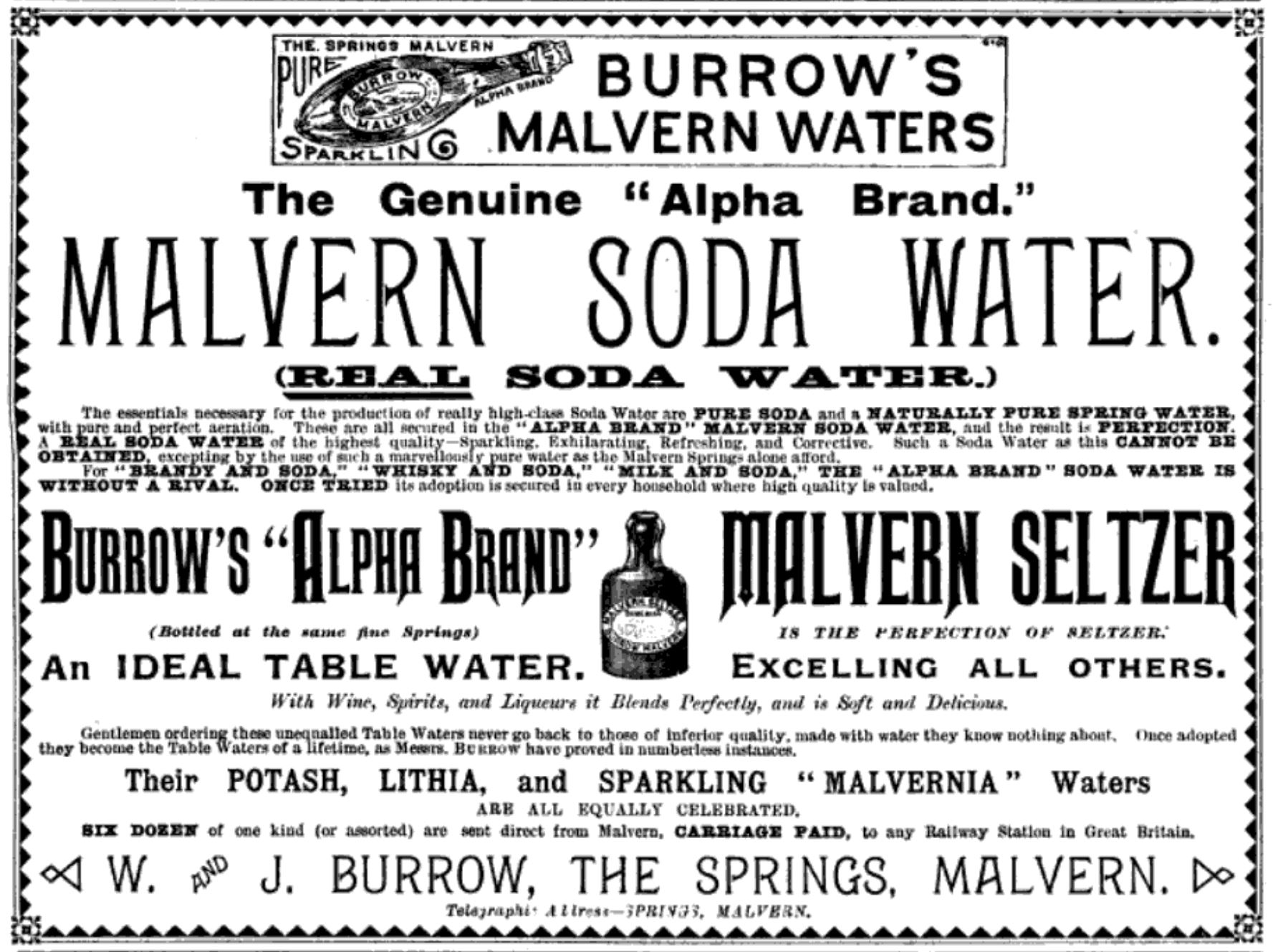 |
 |
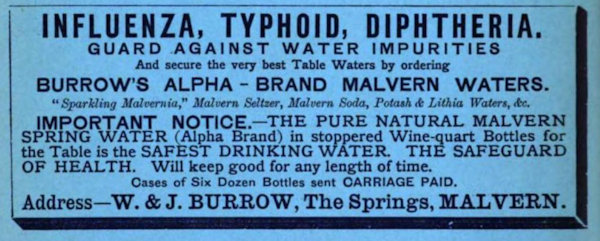 |
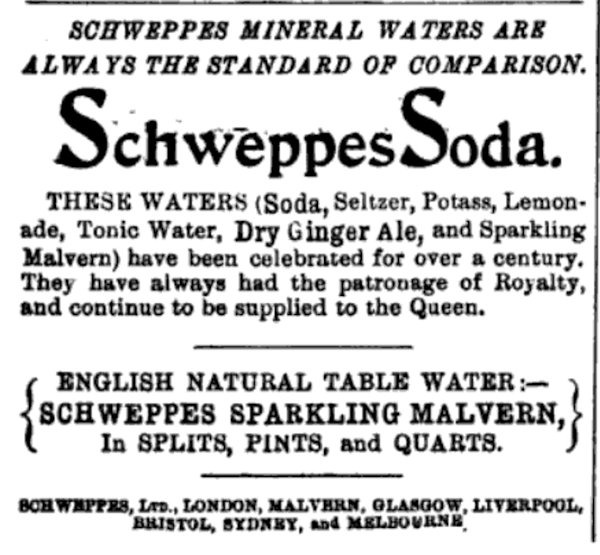 |
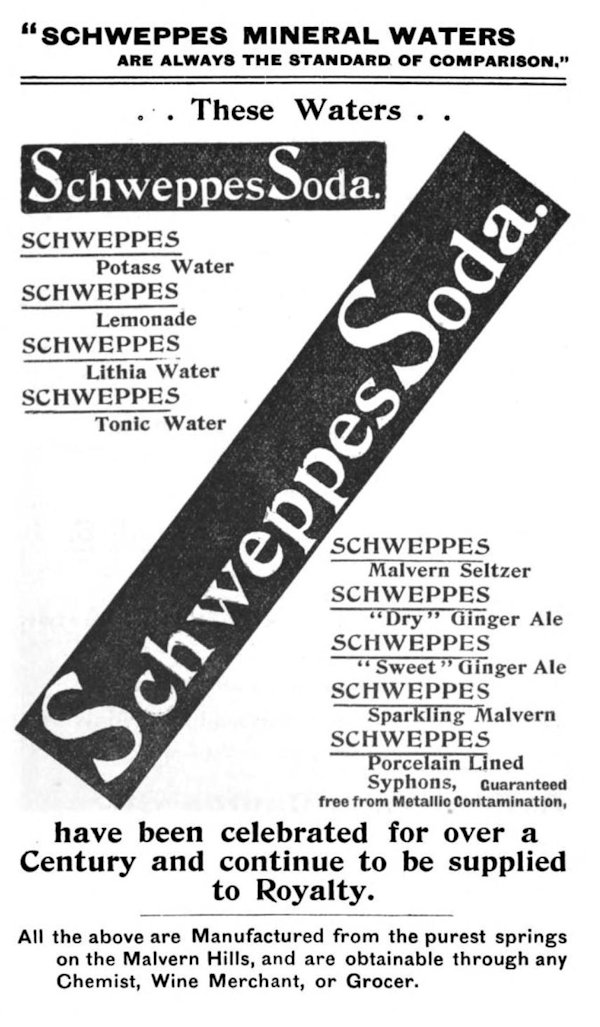 |
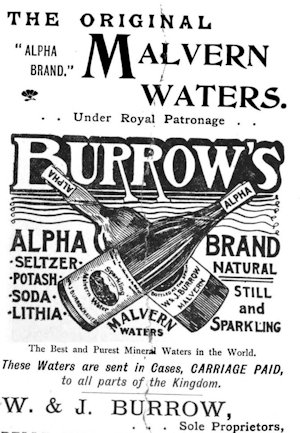 |
Bottling continued at the spring until the late 20th century, when the site fell into disrepair. It was very recently restored in 2006, and, as a listed building, has been looked after ever since. I visited the site in November 2024, and a decent quantity of water was issuing out of the basin, although there were several signs nearby that warned that the water is unfit for drinking, which is rather ironic, considering the fact that, only a hundred years ago, it was drunk in large amounts.
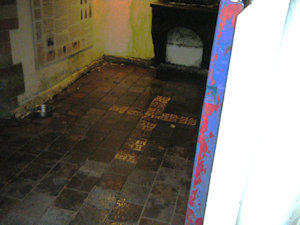 |
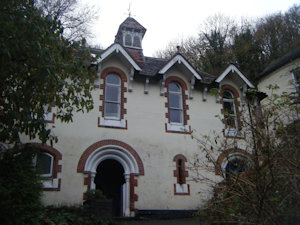 |
 |
|
Access: The well is located at the top of a hill; a road runs up the slope, and there is space for parking at the top. |
Copyright 2025 britishholywells.co.uk